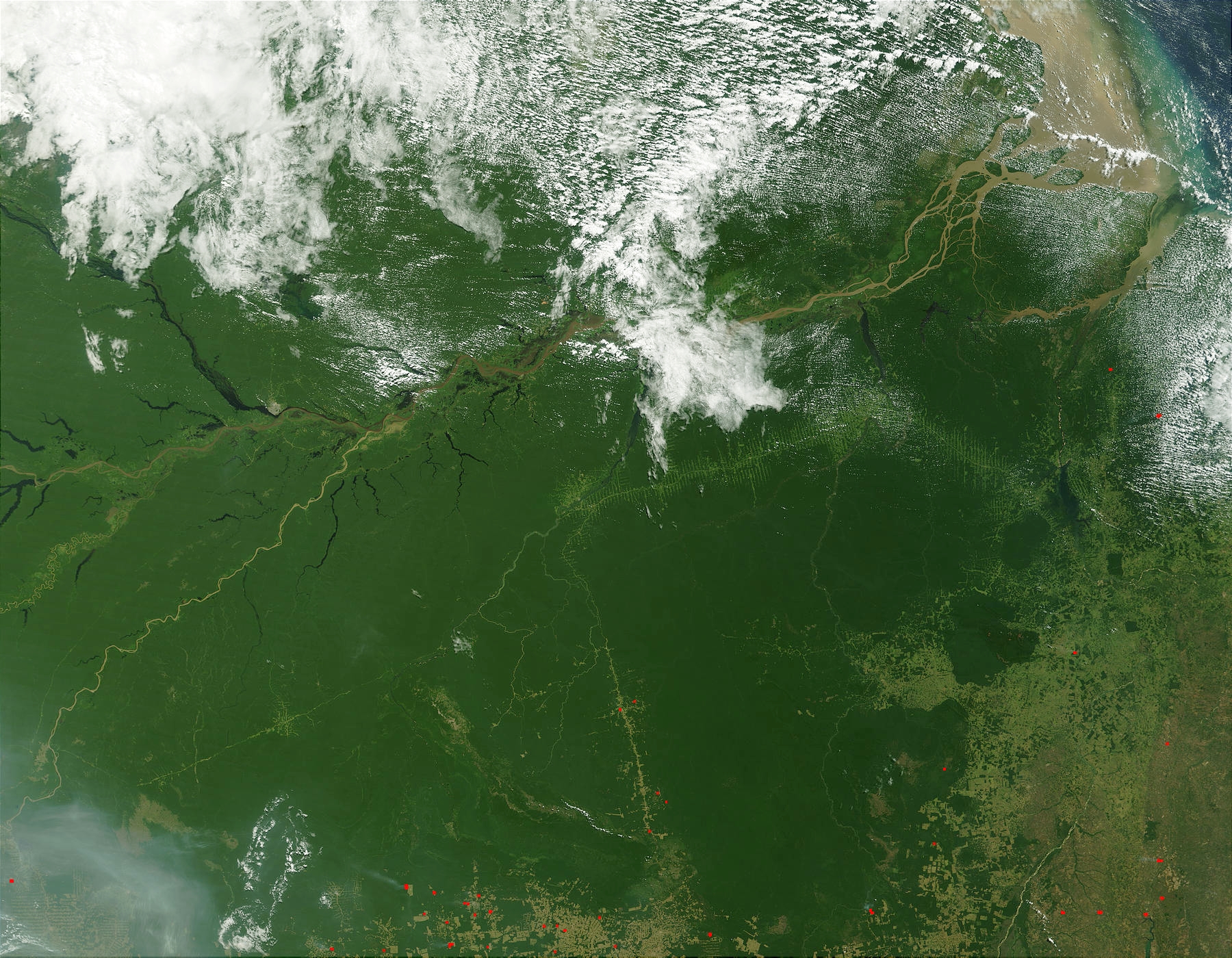|
Conservation In Brazil
Even though progress has been made in conserving Brazil’s landscapes, the country still faces serious threats due to its historical land use. Amazonian forests substantially influence regional and global climates and deforesting this region is both a regional and global driver of climate change due to the high amounts of deforestation and habitat fragmentation that have occurred this region. Brazil has established an extensive network of protected areas which covers more than 2 million km2(25% of Brazil's national territory) and is divided almost equally between protected natural areas or conservation units and indigenous land (" Terras Indígenas"). Despite these measures, environmental protection is still a concern as indigenous tribes and Brazilian environmental activists contend with ranchers, illegal loggers, gold and oil prospectors and drug traffickers who continue to illegally clear forests. Deforestation More than one-fifth of the Amazon Rainforest in Brazil has been c ... [...More Info...] [...Related Items...] OR: [Wikipedia] [Google] [Baidu] |
Brazil
Brazil ( pt, Brasil; ), officially the Federative Republic of Brazil (Portuguese: ), is the largest country in both South America and Latin America. At and with over 217 million people, Brazil is the world's fifth-largest country by area and the seventh most populous. Its capital is Brasília, and its most populous city is São Paulo. The federation is composed of the union of the 26 States of Brazil, states and the Federal District (Brazil), Federal District. It is the largest country to have Portuguese language, Portuguese as an List of territorial entities where Portuguese is an official language, official language and the only one in the Americas; one of the most Multiculturalism, multicultural and ethnically diverse nations, due to over a century of mass Immigration to Brazil, immigration from around the world; and the most populous Catholic Church by country, Roman Catholic-majority country. Bounded by the Atlantic Ocean on the east, Brazil has a Coastline of Brazi ... [...More Info...] [...Related Items...] OR: [Wikipedia] [Google] [Baidu] |
Forest
A forest is an area of land dominated by trees. Hundreds of definitions of forest are used throughout the world, incorporating factors such as tree density, tree height, land use, legal standing, and ecological function. The United Nations' Food and Agriculture Organization (FAO) defines a forest as, "Land spanning more than 0.5 hectares with trees higher than 5 meters and a canopy cover of more than 10 percent, or trees able to reach these thresholds ''in situ''. It does not include land that is predominantly under agricultural or urban use." Using this definition, '' Global Forest Resources Assessment 2020'' (FRA 2020) found that forests covered , or approximately 31 percent of the world's land area in 2020. Forests are the predominant terrestrial ecosystem of Earth, and are found around the globe. More than half of the world's forests are found in only five countries (Brazil, Canada, China, Russia, and the United States). The largest share of forests (45 percent) are in th ... [...More Info...] [...Related Items...] OR: [Wikipedia] [Google] [Baidu] |
Jacaranda
''Jacaranda'' is a genus of 49 species of flowering plants in the family Bignoniaceae, native to tropical and subtropical regions of the Americas. The generic name is also used as the common name. The species ''Jacaranda mimosifolia'' has achieved a cosmopolitan distribution due to introductions, to the extent that it has entered popular culture. It can be found growing wild in Central America, the Caribbean, Spain, southern Africa, China, and Australia. Etymology The name is of South American (more specifically Tupi-Guarani) origin, meaning fragrant. The word ''jacaranda'' was described in ''A supplement to Mr. Chambers's Cyclopædia'', 1st ed., (1753) as "a name given by some authors to the tree the wood of which is the log-wood, used in dyeing and medicine" and as being of Tupi-Guarani origin, by way of Portuguese. Although not consistent with the Guarani source, one common pronunciation of the name in English is given by . Description The species are shrubs to large tree ... [...More Info...] [...Related Items...] OR: [Wikipedia] [Google] [Baidu] |
Brazilian Highlands
The Brazilian Highlands or Brazilian Plateau ( pt, Planalto Brasileiro) are an extensive geographical region, covering most of the eastern, southern and central portions of Brazil, in all approximately half of the country's land area, or some 4,500,000 km2 (1,930,511 sq mi). In addition, the vast majority of Brazil's population (190,755,799; ''2010 census'') lives in the highlands or on the narrow coastal region immediately adjacent to it. Ancient basaltic lava flows gave birth to much of the region. However, the time of dramatic geophysical activity is long past, as there is now no seismic or volcanic activity. Erosion has also played a large part in shaping the Highlands, forming extensive sedimentary deposits and wearing down the mountains. The Brazilian Highlands are recognized for the great diversity to be found there: within the region there are several different biomes, vastly different climatic conditions, many types of soil, and thousands of animal and plant specie ... [...More Info...] [...Related Items...] OR: [Wikipedia] [Google] [Baidu] |
Caatinga
Caatinga (, ) is a type of semi-arid tropical vegetation, and an ecoregion characterized by this vegetation in interior northeastern Brazil. The name "Caatinga" is a Tupi word meaning "white forest" or "white vegetation" (''caa'' = forest, vegetation, ''tinga'' = white). The Caatinga is a xeric shrubland and thorn forest, which consists primarily of small, thorny trees that shed their leaves seasonally. Cacti, thick-stemmed plants, thorny brush, and arid-adapted grasses make up the ground layer. Most vegetation experiences a brief burst of activity during the three-month long rainy season. Caatinga falls entirely within earth's tropical zone and is one of 6 major ecoregions of Brazil. It covers 850,000 km², nearly 10% of Brazil's territory. It is home to 26 million people and over 2000 species of plants, fish, reptiles, amphibians, birds, and mammals. The Caatinga is the only exclusively Brazilian biome, which means that a large part of its biological heritage cannot ... [...More Info...] [...Related Items...] OR: [Wikipedia] [Google] [Baidu] |
EMBRAPA
The Brazilian Agricultural Research Corporation (Embrapa - pt, Empresa Brasileira de Pesquisa Agropecuária) is a state-owned research corporation affiliated with the Brazilian Ministry of Agriculture. Since its inception on April 26, 1973, it has been devoted to developing technologies, knowledge and technical-scientific information aimed at Brazilian agriculture, including livestock.Brazilian scientists turning nation into an agro-power '''', October 16, 2010 Their mission is to ''"develop research, development and innovation solutions for the sustainability of agriculture, for the benefit of Brazilian socie ... [...More Info...] [...Related Items...] OR: [Wikipedia] [Google] [Baidu] |
Cerrado
The ''Cerrado'' (, ) is a vast ecoregion of tropical savanna in eastern Brazil, particularly in the states of Goiás, Mato Grosso do Sul, Mato Grosso, Tocantins, Minas Gerais, and the Federal District. The core areas of the Cerrado biome are the Brazilian highlands – the ''Planalto''. The main habitat types of the Cerrado consist of forest savanna, wooded savanna, park savanna and gramineous-woody savanna. The ''Cerrado'' also includes savanna wetlands and gallery forests. The second largest of Brazil's major habitat types, after the Amazonian rainforest, the Cerrado accounts for a full 21 percent of the country's land area (extending marginally into Paraguay and Bolivia). The first detailed European account of the Brazilian cerrados was provided by Danish botanist Eugenius Warming (1892) in the book ''Lagoa Santa'', : The above is the original. There are other, later French and Portuguese translations not listed here. in which he describes the main features of the c ... [...More Info...] [...Related Items...] OR: [Wikipedia] [Google] [Baidu] |
Constitution Of Brazil
The Constitution of the Federative Republic of Brazil ( pt, Constituição da República Federativa do Brasil) is the supreme law of Brazil. It is the foundation and source of the legal authority underlying the existence of Brazil and the federal government of Brazil. It provides the framework for the organization of the Brazilian government and for the relationship of the federal government to the states, to citizens, and to all people within Brazil. Overview The current Brazilian Constitution is the seventh enacted since the country's independence in 1822, and the sixth since the proclamation of the republic in 1889. It was promulgated on 5 October 1988, after a two-year process in which it was written from scratch. History The current Constitution of Brazil was drafted as a reaction to the period of military dictatorship, and sought to guarantee individual rights and restrict the state's ability to limit freedom, to punish offences and to regulate individual life. Among ... [...More Info...] [...Related Items...] OR: [Wikipedia] [Google] [Baidu] |
United States
The United States of America (U.S.A. or USA), commonly known as the United States (U.S. or US) or America, is a country primarily located in North America. It consists of 50 states, a federal district, five major unincorporated territories, nine Minor Outlying Islands, and 326 Indian reservations. The United States is also in free association with three Pacific Island sovereign states: the Federated States of Micronesia, the Marshall Islands, and the Republic of Palau. It is the world's third-largest country by both land and total area. It shares land borders with Canada to its north and with Mexico to its south and has maritime borders with the Bahamas, Cuba, Russia, and other nations. With a population of over 333 million, it is the most populous country in the Americas and the third most populous in the world. The national capital of the United States is Washington, D.C. and its most populous city and principal financial center is New York City. Paleo-Americ ... [...More Info...] [...Related Items...] OR: [Wikipedia] [Google] [Baidu] |
Brazil Soybean Production Regions 2020
Brazil ( pt, Brasil; ), officially the Federative Republic of Brazil (Portuguese: ), is the largest country in both South America and Latin America. At and with over 217 million people, Brazil is the world's fifth-largest country by area and the seventh most populous. Its capital is Brasília, and its most populous city is São Paulo. The federation is composed of the union of the 26 states and the Federal District. It is the largest country to have Portuguese as an official language and the only one in the Americas; one of the most multicultural and ethnically diverse nations, due to over a century of mass immigration from around the world; and the most populous Roman Catholic-majority country. Bounded by the Atlantic Ocean on the east, Brazil has a coastline of . It borders all other countries and territories in South America except Ecuador and Chile and covers roughly half of the continent's land area. Its Amazon basin includes a vast tropical forest, ho ... [...More Info...] [...Related Items...] OR: [Wikipedia] [Google] [Baidu] |

.jpg)

